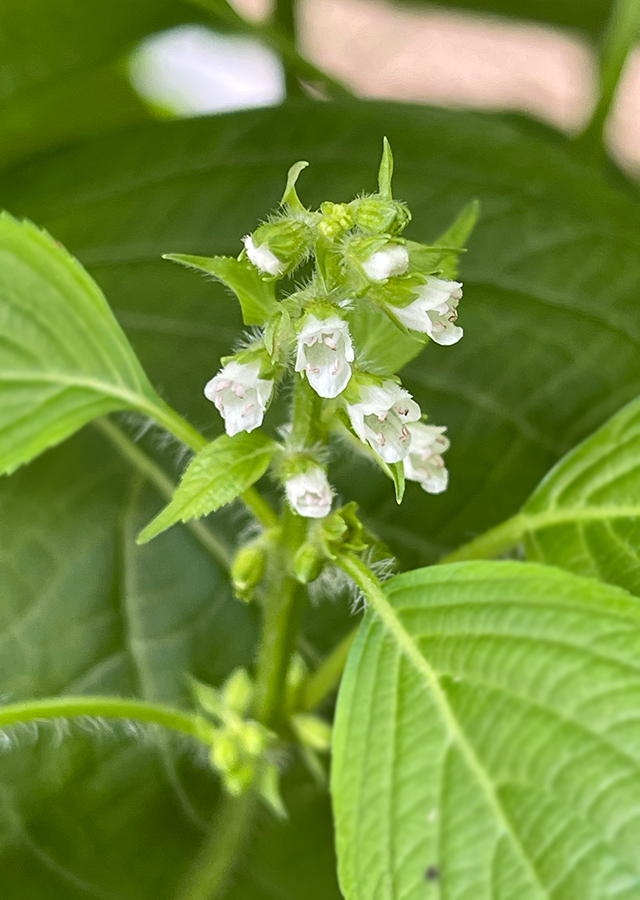Beefsteak Plant
Perilla frutescens (L.) Britton
Lamiaceae
Location in our garden
Principal



Synonym
Ocimum frutescens L.
Perilla frutescens var. typica Makino
Perilla ocymoides L.
Perilla urticifolia Salisb.
Habitus
Herbaceous. Annual to perennial herbs, grows around 25-200 cm.
Part Used
Leaves
Seeds
Stem
Growing Requirements
Full Sunshine
Habitat
Mountains
Roadside
Overview
P. frutescens is an aromatic plant originating from India, Nepal, Bangladesh, Myanmar, southern and eastern China, Korea, Japan, Indochina, Indonesia (Java). China, India, Japan, Korea, Thailand and other East Asian countries are the major perilla cultivating countries. This plant has a long history of use in many Asian countries and is now used all over the world. P. frutescens has been cultivated for over two thousand years in China. It has been used for various purposes, namely as an aromatic plant, ornamental plant, and medicinal plant, especially used in traditional Chinese medicine (TCM) and is listed in the 2010 Chinese Pharmacopoeia. This plant is believed to be able to overcome various disease complaints, including diseases related to depression. Additionally, the leaves can be consumed as a vegetable, marinated with tamarind or salt as a side dish, or boiled into soup for drinking, a spice and flavor enhancer in cooking meat, sweets and sauces, and as a food coloring. The seeds produce an oil that can be used as cooking oil in some parts of the world, it also has market importance in cosmetics (skin creams, soaps and dermatological preparations), drying oil (in paints, varnishes, inks), waterproof coatings on fabrics. Perilla alcohol is used in the perfume industry as a fragrance.
Vernacular Names
Périlla (Frensh), Shiso (Japanese).
Agroecology
P. frutescens is generally found growing in grasslands and fields, dry forests, along roadsides, around houses, trash places, it also grows on hills and mountains in central and southern Japan. This plant can be cultivated as an annual plant from warm climates to tropical areas. It thrives in well-drained soil as well as moist, nutrient-rich soil. Likes light (sandy) and medium (clay), neutral and alkaline acidic soils. The plant is drought tolerant, but not frost tolerant and requires temperatures above 18 °C. It also requires warm weather conditions and can grow in full sun and light shade (not dark). However, seeds need light to germinate.
Morphology
- Stems - erect, square with four notches, purple or green covered with short hairs (pubescent), fragrant, often heavily branched.
- Leaves - opposite, with a wrinkled ovate shape, pointed tip, serrated (saw-toothed) leaf edges, and long leaf stalks. The leaves are green with a touch of purple on the underside, aromatic.
- Flowers - blooms along the axes (racemes) at the tips of branches and main stems. The flowers are small, two-lipped bell-shaped, white. The flower petals are 3-4 mm long, consisting of an upper three sepals and two lower, hairy sepals. The flower crown is 4-5 mm long with the bottom lip being longer than the top lip. There are four stamens, two of which are elongated.
- Fruits - schizocarp with a reticulate pattern on the outside and 2 mm in diameter, gray-brown to black-brown in color.
- Seeds - soft to hard, white, gray, brown and dark brown, round shape.
Cultivation
Propagated by seeds - Surface-sow or only lightly cover the seed. The seed germinates best at 20°c, though it also succeeds at slightly lower temperatures. Germination is usually quick. The seed has a short viability and should be used when less than a year old.
Chemical Constituents
Phenolic compounds (rosmarinic acid, caffeic acid, and ferulic acid), flavonoids (luteolin, quercetin, and apigenin), catechins, phytosterols, tocopherols,
squalene, policosanol, α-linolenic acid, linoleic acid, triterpenes, steroids, essential oils (monoterpene types: perillaldehyde, perilla ketone, citral (a mixture of neral and geranial), perillen, piperitenone, shisofuran, and elsholtziaketone; phenylpropylene: dillapiol, dilapidil, myristin, elemicin, nothoapiol).
Traditional Medicinal Uses
- The leaves, stems and seeds of shiso are often used in Oriental medicine. It is a pungent, aromatic, warming herb that is antibacterial, antidote, antipyretic, antiseptic, antispasmodic, antitussive, carminative, diaphoretic, emollient, expectorant, pectoral, stomachic and tonic.
- The leaves are used in the treatment of colds, chest stuffiness, vomiting, abdominal pain etc.
- The juice of the leaves is applied to cuts and wounds.
- The seed is antiasthmatic, antitussive, emollient and expectorant.
- It is used internally in the treatment of asthma, colds and chills, nausea, abdominal pain, food poisoning and allergic reactions (especially from seafood), bronchitis and constipation.
- The stems are a traditional Chinese remedy for morning sickness.
- This herb should be avoided by pregnant women.
Part Used
Reference Sources
- Perilla frutescens (L.) Britton | Plants of the World Online | Kew Science
- Perilla frutescens - Useful Tropical Plants (theferns.info)
- Perilla frutescens - Useful Tropical Plants (theferns.info)
- Perilla frutescens (Beefsteak Plant, Perilla, Shiso) | North Carolina Extension Gardener Plant Toolbox (ncsu.edu)
- VANITA, K., MEGH, T. dan SHIVAM, D., 2022. PERILLA FRUTESCENS–A REVIEW ON PHARMACOLOGICAL ACTIVITIES, EXTRACTION PROCEDURE AND APPLICATIONS. Asian J Pharm Clin Res, 15(8), pp.34-40.
- Wu, X., Dong, S., Chen, H., Guo, M., Sun, Z. and Luo, H., 2023. Perilla frutescens: A traditional medicine and food homologous plant. Chinese Herbal Medicines.


